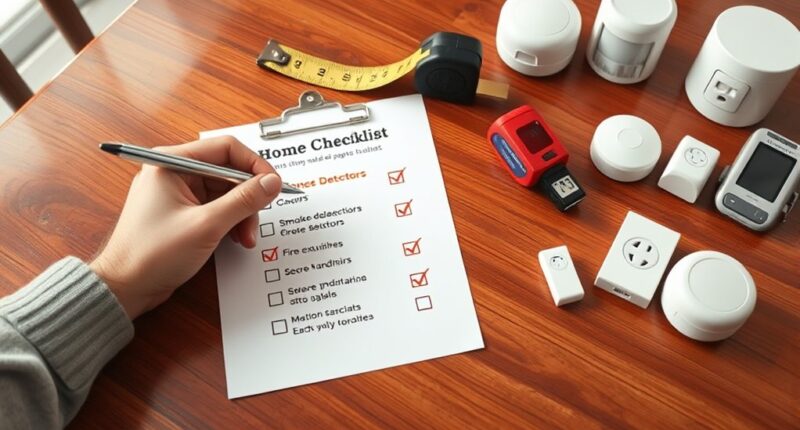To measure your home safety checklist the right way, start by systematically reviewing key areas like structural stability, fire and electrical safety, emergency exits, hazardous materials storage, and security systems. Regular inspections help identify issues early, while keeping safety equipment updated ensures readiness. Focus on ventilation and ongoing maintenance, too. Following a thorough approach ensures your home remains safe and secure. Continue with this guide to uncover more detailed steps you can take.
Key Takeaways
- Conduct comprehensive structural assessments to identify foundational and load-bearing issues early.
- Regularly test fire alarms, electrical systems, and emergency exits for proper functionality.
- Properly label and securely store hazardous materials, inspecting storage areas quarterly.
- Ensure security devices like smart locks and surveillance cameras are operational and cover all entry points.
- Maintain routine checks of safety devices, signage, and maintenance tasks to promote ongoing home safety.
Assessing Structural Integrity and Stability

Before inspecting your home’s safety, it’s essential to evaluate its structural integrity and stability. Start by examining the foundation stability, which is vital for supporting the entire structure. Look for cracks, uneven surfaces, or signs of shifting, as these indicate potential problems. Check the load bearing capacity of load-bearing walls and columns to ensure they can handle the weight above them. If you notice any sagging floors, bowing walls, or visible deterioration, these could compromise stability. It’s important to address issues early before they worsen. Remember, a solid foundation and sufficient load bearing capacity are the backbone of a safe home. Regular inspections help you catch problems when they’re manageable, safeguarding your home and family. Incorporating professional assessments into your routine ensures more accurate evaluations and peace of mind.
Checking Fire and Electrical Safety Measures

Once you’ve assessed your home’s structural stability, it’s time to turn your attention to fire and electrical safety measures. Check that your fire alarm is functioning properly by testing it and replacing batteries if needed. Ensure your circuit breaker is labeled correctly and easily accessible in case of emergencies. Regularly inspect electrical cords for damage, and avoid overloading outlets. Consider replacing outdated wiring or appliances that pose fire risks. To deepen your understanding, review this quick comparison:
| Fire Safety | Electrical Safety |
|---|---|
| Functioning fire alarm | Properly labeled circuit breaker |
| Working smoke detectors | No damaged electrical cords |
| Fire extinguishers in place | No overloaded outlets |
Being aware of contrast ratio and its impact on home cinema projectors can also help you create a safer and more enjoyable viewing environment.
Evaluating Emergency Preparedness and Exits

You need to make certain your exit pathways are clear at all times so you can evacuate quickly in an emergency. Check that emergency equipment, like fire extinguishers and first aid kits, is easily accessible. Also, make sure exit signs are visible and well-lit to guide everyone safely out of your home. Incorporating wall organization systems can help keep clutter away from exits, ensuring clear pathways during emergencies.
Clear Exit Pathways
Ensuring clear exit pathways is essential for effective emergency preparedness, as blocked or cluttered routes can delay or prevent safe evacuation. You should regularly check that your fire escape routes remain unobstructed, especially near exits and windows. Additionally, guarantee stairway clearance is maintained; furniture, boxes, or debris shouldn’t block stairs, allowing for quick and safe movement. Clear pathways reduce the risk of trips and falls during an emergency, providing a safe route for everyone to evacuate swiftly. Keep exits free of clutter and guarantee doors open easily without obstruction. Regularly inspect these pathways, especially in high-traffic or storage areas, to maintain quick access. Properly maintained exit routes are crucial for minimizing chaos and ensuring everyone’s safety during emergencies. Regularly verifying the safety of juicing methods can help prevent accidents that might block pathways or cause spills.
Emergency Equipment Accessibility
Evaluating the accessibility of your emergency equipment is a vital step in ensuring your home is prepared for any crisis. You need to confirm that first aid kits, fire extinguishers, and emergency supplies are easy to reach from all key areas. Regularly conduct emergency drills to test how quickly you can locate and use this equipment under stress. Make sure first aid supplies are stored in clearly marked, accessible locations, not tucked away in hard-to-reach cabinets. Check that fire extinguishers are visible and unobstructed, ready for immediate use. Incorporating Powerful persuasive words into your safety communication can motivate family members to prioritize emergency preparedness. By maintaining easy access and practicing emergency drills, you’ll improve your response time and overall safety, ensuring you’re prepared to handle unexpected situations effectively.
Exit Sign Visibility
Are exit signs clearly visible in all areas of your home? Exit sign visibility is vital for safe evacuation during emergencies. Check that signs are unobstructed and easy to see from any direction. Proper emergency lighting enhances visibility, especially in power outages, ensuring signs remain illuminated. Make sure the signs are bright enough and properly placed near stairways, hallways, and exits. Regularly test the lighting system to confirm it functions correctly. If signs are faded or hidden, replace them immediately. Adequate exit sign visibility guides everyone to safety quickly, reducing panic and confusion. Remember, well-lit emergency signs combined with reliable emergency lighting can make all the difference during a fire or other urgent situation. Stay proactive to protect your household.
Inspecting Safe Storage of Hazardous Materials

You need to check that hazardous materials are properly labeled so you can identify them quickly. Make sure they’re stored securely in appropriate containers or cabinets to prevent accidents. Regular safety audits help guarantee storage remains safe and compliant with guidelines. Additionally, vetted safety products can enhance storage safety and reduce risks.
Proper Labeling Practices
Proper labeling is essential to guarantee hazardous materials are stored safely and easily identifiable. Use clear, durable labeling labels that include important information such as contents, date of storage, and hazard warnings. Follow signage standards to ensure labels are visible and legible from a distance. Consistent labeling helps prevent accidental misuse or mixing of chemicals, reducing safety risks. Make sure labels are resistant to moisture, heat, and chemicals to maintain clarity over time. When labeling, avoid ambiguous language and use universal symbols or icons to communicate hazards clearly. Regularly check labels for damage or fading, and replace them promptly. Proper labeling practices create a safer home environment by ensuring everyone understands the risks associated with stored hazardous materials. Additionally, understanding emotional support can help families cope better with the stresses related to managing hazardous materials and maintaining safety at home.
Secure Storage Solutions
To guarantee hazardous materials are stored safely, regularly inspect your storage areas for security and integrity. Ensure child proofing measures are in place, such as safety locks or latches, to prevent children from accessing dangerous substances. Check that containers are sealed properly and stored away from heat sources or moisture. Good lock and key management is essential—keep keys in a secure location inaccessible to children or unauthorized individuals. Confirm that storage cabinets or closets are sturdy and in good condition, with no signs of damage or tampering. Maintain an organized system so hazardous materials are easily identifiable and accessible only to responsible adults. Regular home safety assessments can help identify potential risks and improve your overall safety procedures, preventing accidents and keeping your home safe for everyone.
Regular Safety Audits
Regular safety audits are essential for maintaining the security and proper storage of hazardous materials in your home. During these audits, you check that all items are stored in appropriate containers and away from heat or moisture. Use home safety gadgets like lockable cabinets or spill containment trays to enhance safety. These tools help prevent accidents and assure compliance with safety standards. Incorporating safety training into your routine improves awareness of safe handling practices to stay aware of proper storage practices and recognize potential risks. Regularly reviewing your storage setup allows you to identify issues early and correct them before they become hazards. Conduct these audits at least quarterly, and document your findings. Staying proactive through consistent safety checks keeps your home safer and helps you respond quickly to any storage-related concerns.
Reviewing Home Security Systems and Measures

Evaluating your home security systems and measures is a crucial step in ensuring safety. You should regularly review how well your security setup works and identify areas for improvement. Start by checking your smart locks to ensure they function properly and are updated with the latest firmware. Next, assess your surveillance cameras—verify they cover all critical entry points and are recording clearly. Finally, consider whether your current measures deter intruders effectively or if adding additional layers, like motion detectors or alarm systems, could boost security. Keep in mind that technology evolves, so staying informed about new smart locks and camera features helps you adapt your security plan. Regular reviews help you spot vulnerabilities and maintain a safer home environment. Understanding the role of aura can also provide insights into personal and environmental energies that may influence home safety.
Ensuring Proper Ventilation and Air Quality

After reviewing your home security systems, it’s equally important to focus on maintaining good indoor air quality and proper ventilation. Poor air quality can lead to health issues and reduce overall safety. Make certain your ventilation systems are functioning effectively by checking for adequate airflow in every room. Use exhaust fans in kitchens and bathrooms to remove excess moisture and pollutants. Open windows regularly to let fresh air circulate, especially when indoor air feels stale. Consider installing air purifiers if you live in areas with high pollution or allergens. Proper ventilation reduces indoor air pollutants such as dust, mold, and volatile organic compounds, creating a healthier environment. Regularly assess your ventilation systems to keep indoor air clean and safe for everyone in your home. Ensuring proper ventilation techniques is essential for maintaining a safe and healthy living space.
Conducting Regular Maintenance and Upkeep

Maintaining your home’s safety requires ongoing effort, and staying on top of routine maintenance is essential for preventing hazards before they arise. Regular upkeep reduces home safety distractions that could lead to accidents. To stay organized, create a maintenance scheduling system that prompts you to inspect critical areas. Incorporating home safety devices into your routine ensures continuous protection. Here are three key steps:
- Schedule monthly checks of smoke detectors and carbon monoxide alarms.
- Inspect electrical wiring and outlets for wear or damage.
- Clean gutters and drains to prevent water damage and mold growth.
Frequently Asked Questions
How Often Should I Perform a Home Safety Checklist?
You should perform a home safety checklist at least every three to six months. Regular checks guarantee your fire escape routes are clear and emergency contacts are updated. During each inspection, verify smoke alarms work and look for hazards. Staying consistent helps you catch problems early, keeping your family safe. Don’t forget to practice fire drills and review safety procedures regularly to stay prepared for emergencies.
What Tools Are Needed to Assess Home Safety Effectively?
To assess home safety effectively, you’ll need a few trusty tools—think a flashlight for dark corners, a ladder to reach smoke detectors, and a checklist to track your progress. Don’t forget fire alarms and smoke detectors; test them regularly to verify they’re working. A screwdriver can help tighten loose fixtures, and a camera can document hazards. Remember, a well-equipped toolkit turns safety checks from chore to cheer!
Can I Conduct Safety Checks Myself or Should I Hire a Professional?
You can definitely do DIY safety checks yourself, especially for basic assessments like smoke detectors and fall hazards. However, for a thorough safety evaluation, a professional assessment is advisable. Professionals can identify issues you might overlook and provide expert solutions. Combining DIY safety measures with occasional professional assessments ensures your home stays as safe as possible. Always prioritize safety and don’t hesitate to seek expert help when needed.
How Do I Prioritize Safety Issues Identified During Inspections?
Think of safety issues like a fire in your home—address the most urgent first. You should perform a risk assessment to identify hazards, then follow a safety hierarchy: eliminate, substitute, or isolate risks before considering controls. Prioritize issues that pose immediate danger, like electrical hazards or tripping risks, and tackle them first. This approach guarantees you effectively reduce danger, making your home safer for everyone.
Are There Seasonal Safety Considerations I Should Be Aware Of?
Yes, you should be aware of seasonal hazards and weather preparedness. During winter, check for icy walkways and confirm your heating system is safe. In summer, watch out for heat-related risks and secure outdoor furniture. Spring and fall bring their own hazards like storms or fallen leaves that can cause slips. Regularly evaluate your home’s safety measures for each season to minimize risks and stay prepared year-round.
Conclusion
By following this home safety checklist, you’re turning your house into an impenetrable fortress of security and comfort. Regularly assess each area to catch issues before they become emergencies—think of it as your secret weapon against disasters. Stay vigilant, keep your home in top shape, and you’ll create a safe haven that’s as resilient as a mountain. Remember, your proactive efforts can make all the difference—your home’s safety depends on you!










